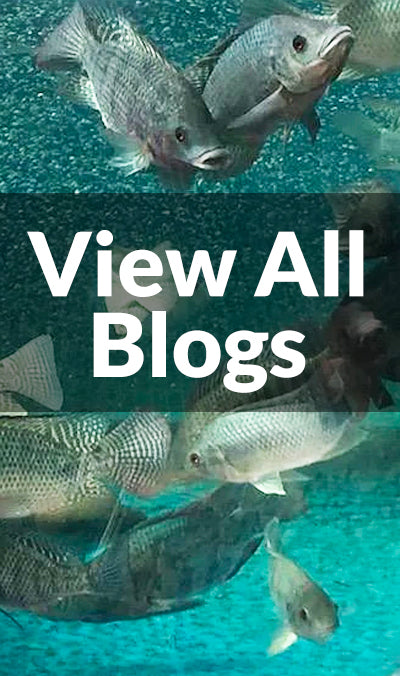Fish play an important role in an aquaponics system. They produce the waste that the plants need to grow and survive. So if you want your aquaponics system to be successful for many years to come, preventing fish diseases should always be your primary concern, since fish are the critical component of your aquaponics system.
It is essential you should be able to provide fish with the things they need and ensure their health is always taken care of. In this article, you'll learn about fish health and diseases in an aquaponics system and how to prevent them from infecting your fish.
Fish Selection in Aquaponics
The fish species recorded to have excellent growth rates in aquaponics systems are tilapia, carp, barramundi. jade perch, catfish, trout, salmon, murray cod, koi, goldfish and largemouth bass.
In adding fish to the system, it is essential to acclimatize the fish first, to remove the stressful factors that can cause death to the new fish. The two simple ways of acclimating your fish are:
- Keep the new fish in a small aerated container with their original water and slowly add water from the fish tank over a day.
- Slowly allowing the temperature to equilibrate by floating the sealed transportation bags containing the fish in the fish tank for at least 15 minutes. Then slowly add a small amount of fish tank water to the transportation bag.
Understanding Fish Diseases in Aquaponics Systems
Fish diseases usually occur when you fail to maintain your aquaponics system properly. Pathogens such as bacteria, parasites, and fungus can propagate rapidly and enter the system by introducing fish or expanding organisms in the fish tank.
Abnormality or unbalance between your system’s environment, pathogen agents, and the fish in your fish tank will probably lead to various problems. This is why maintaining good water quality through regular management practice is essential. With regular maintenance practice, not only will you be able to prevent various diseases, but it will also ensure the entire system is well-maintained and running smoothly.
Causes of Fish Diseases in Aquaponics
Fish disease in aquaponics is always the result of abiotic and biotic factors. Abiotic are non-living chemical factors that affect toxicity or water quality. Biotic factors are living pathogens or organisms that can directly or indirectly affect their environment. Like other animals, fish also carry bacteria, viruses, fungus, and parasites. Though not all these bacteria are harmful, some of these microorganisms can potentially cause fish diseases.
The following factors can cause fish diseases in your aquaponics system.
1. Water Quality Issues
a. Ammonia and Nitrate Levels:
- Elevated ammonia levels, a natural byproduct of fish waste, can be toxic.
- Nitrate levels produced during the nitrogen cycle can also become harmful in excess.
- Poor water quality compromises fish health, making them more susceptible to diseases.
b. pH Imbalance:
- Fluctuations in pH levels can stress fish and weaken their immune systems.
- Extreme acidity or alkalinity can directly contribute to the onset of diseases.
c. Temperature Fluctuations:
- Drastic changes in water temperature can stress fish and compromise their ability to resist infections.
- Certain diseases thrive in specific temperature ranges, making consistent control essential.
2. Poor System Design and Maintenance
a. Inadequate Filtration:
- Inefficient filtration allows the accumulation of uneaten food and fish waste, leading to poor water quality.
- Lack of mechanical and biological filtration can disrupt the balance of the aquaponics system.
b. Overcrowding:
- Excessive fish density in a confined space increases stress and competition.
- Overcrowded conditions facilitate the rapid spread of diseases.
c. Lack of Quarantine Procedures:
- Introducing new fish without proper quarantine increases the risk of introducing pathogens.
- Infected individuals can quickly spread diseases to the entire population.
d. Insufficient Aeration:
- Inadequate oxygenation can stress fish and weaken their immune systems.
- Proper aeration is crucial for the well-being of both fish and beneficial bacteria.
e. Neglecting Regular Checks:
- Failure to routinely monitor water parameters and system components.
- Neglecting maintenance tasks can lead to unforeseen issues that compromise the system's overall health.
3. Inadequate Fish Nutrition:
a. Imbalanced Diet:
- The lack of essential nutrients in fish feed weakens the immune system.
- Nutritional deficiencies make fish more susceptible to infections.
b. Overfeeding or Underfeeding:
- Overfeeding leads to excess uneaten food, contributing to poor water quality.
- Underfeeding deprives fish of the necessary nutrients, compromising their health.

How to Recognize Fish Diseases in Aquaponics Systems
Sometimes, fish diseases still occur even if you apply all the prevention techniques. So it is important to monitor regularly your aquaponics system to recognize fish disease symptoms early and take the necessary action.
Signs of Fish Diseases:
- Ulcers on the body surface, discolored patches, and white or black spots.
- Ragged fins.
- Gill and fin necrosis and decay.
- Twisted spine and abnormal body configuration.
- Extended abdomen or swollen appearance.
- Swollen popped out eyes.
- Poor appetite.
- Lethargy or changes in swimming patterns.
- Odd position in the water, such as head or tail down or difficulty in maintaining buoyancy.
- Gasping for air on the surface.
- Fish rubbing or scraping against the fish tank.
Common Fish Diseases in Aquaponics Systems
To help you identify and accordingly act on your fish health issues, here is the list of causes and symptoms of common fish diseases of aquaponics fish. For a more list of fish disease in aquaponics, click here.
1. Nitrite Poisoning
A new aquaponics system is more vulnerable to nitrite poisoning, especially when they are not yet correctly colonized by beneficial bacteria. However, nitrite poisoning is not just limited to new systems; established aquaponics systems can have nitrite poisoning when the nitrites level goes over six ppm. The causes of nitrite poisoning are new tank syndrome,failure of the biofilter, fish overcrowding in the fish tank, recently washed biofilter or media, reduced water flow, and temperature drop.
Symptoms of Nitrite Poisoning:
- Breathing difficulty
- Darker gills
- Brownish blood
- Abnormal swimming
- Gathering near the water's surface
- Lethargy
- Redness around the eyes and fins
Treatments of Nitrite Poisoning:
- Immediate (20-50%) water replacement
- Add biofilter media
- Reduce fish density
- Stop feeding
- Add chloride
- Improve aeration
- Adjust the temperature
- Avoid fish disturbance
2. Temperature Stress
Temperature stress is caused by the rapid change in temperature or when the temperature is not in its normal range, bad insulation, or faulty system management. The most common cause of temperature stress is lack of heating or insulation and improper management of the system.
Symptoms of Temperature Stress:
- Lethargy
- Mold disease (hypothermia)
- Dyspnea (hyperthermia)
Treatments of Temperature Stress:
- Insulate the fish tank
- Add a water heater
- Shade the tank
- Ventilate at night
- Use a cooling system
- Use a greenhouse in cold seasons
3. Ammonia Poisoning
Excessive ammonia is harmful to the fish. Increased pH levels may cause ammonia poisoning in the fish tank. The causes of ammonia poisoning are new tank syndrome, biofilter failure, too many fish in the tank, overfeeding and failure to remove uneaten fish food, reduced water flow, decreased oxygen, and temperature drop, which inhibits the nitrifying bacteria.
Symptoms of Ammonia Poisoning:
- Abnormal swimming patterns
- Not eating during feeding
- Darker gills
- Larger gills (hyperplasia for chronic toxicity)
- Redness around the eyes and fins.
Treatments of Ammonia Poisoning:
- Immediate (20-50%) water exchange
- Reduce pH with acid buffer
- Add biofilter media
- Improve oxygenation
- Adjust temperatures
- Stop feeding
4. Fin Rot
Fin rot is often caused by bacterial infection from different agents, poor water conditions, and bullying from other fish.
Symptoms of Fin Rot:
- Damaged fin ray exposed
- Loss of color
- Bleeding
- Ulceration
Treatments of Fin Rot:
- Identify the causes.
- Treat the infected fish in a separate tank and provide medicated fish food with antibiotics (chloramphenicol or tetracycline) or dissolve the antibiotic directly in the water.
- Keep sick fish separate until fully recovered.
5. White Cotton Saprolegnia
White cotton Saprolegnia is typically a fungus disease caused by temperature drop, concurrent causes of acute stress, and transport stress.
Symptoms of White Saprolegnia:
- White, brown, or red, cotton-ish growth on the fish surface.
- Ocular lesions as cloudy eyes causing blindness and loss of the organ.
Treatments of Saprolegnia:
- Prolonged formalin or salt bath.
- Treatment of eggs with hydrogen peroxide, or prolonged immersion in methylene blue.
- Lesions may be treated with a cloth soaked with povidone-iodine.
6. Fish Fungus
Also known as cotton wool disease or fuzzy fish, the fish fungus looks like a cotton-like growth on the skin or fins. Fungal spores are common in poorly maintained tanks, poor water conditions, or damaged fish tissues from wounds.
Treatments of Fish Fungus:
The first and essential thing you need to do is a water test to establish if poor water conditions cause fish disease. If there are other problems, such as ammonia and nitrite levels, you need to ensure that ammonia and nitrite levels are within their ideal range.

How to Prevent Fish Diseases in Aquaponics
Below is a list of how you can prevent fish diseases in your aquaponics system.
- Purchase healthy fish from a reliable and reputable hatchery.
- Quarantine new fish in an isolation tank for a few days before adding them to your system.
- Ensure that the water source is of a reliable origin and good quality.
- Remove chlorine from the water.
- Maintain the key good water quality parameters at all times.
- Avoid sudden changes in pH, ammonia, DO, and temperature in the water.
- Ensure adequate aeration to keep DO levels high at all times.
- Ensure that the fish tank is shaded from the direct sunlight.
- Prevent birds and other animals from entering your system that can be the source of pathogens or parasites.
- Follow standard hygiene procedures by cleaning, washing hands, and sterilizing equipment.
- Use one fishnet for each fish tank to avoid cross-contamination of diseases.
-
Avoid loud noise and flickering lights near the fish tank.
Conclusion
Fish health is very important in aquaponics systems. A healthy fish is necessary for the overall success of your aquaponics system. So when you decide on the fish species for your system, know its growing requirements and provide the ideal environment for them. This way, you can be sure you are preventing fish disease and enjoying a bountiful harvest from your aquaponics system.
Always keep in mind to always remove the infected fish from the tank before treating it with a salt bath or other fish treatment methods. Thank you for reading our article. Subscribe to ournewsletter to get regular aquaponics updates.






Leave a comment (all fields required)